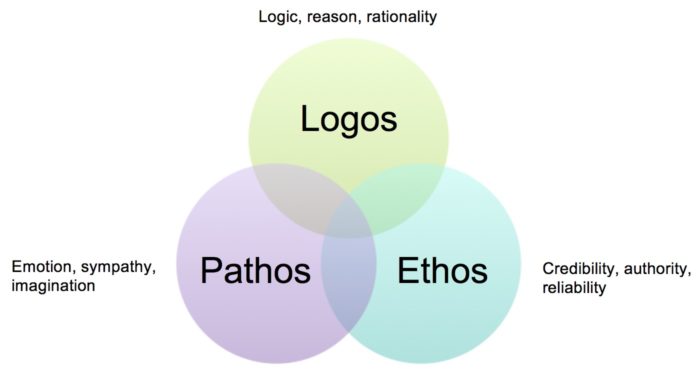
Week 11: Rhetoric Model of Persuasion
Models of Persuasion
Persuasion is the use of appeals to reasons, values, beliefs, and emotions to convince a listener or reader to think or act in a particular way.
Rhetoric Model of Persuasion
The Rhetoric Model of Persuasion was given by Aristotle. He explained the model by dividing into several modes. Of the modes of persuasion furnished by the spoken word there are three kinds.
- The first kind depends on the personal character of the speaker [ethos]
- The second on putting the audience into a certain frame of mind [pathos]
- The third on the proof, or apparent proof, provided by the words of the speech itself [logos].
Persuasion is achieved by the speaker’s personal character when the speech is so spoken as to make us think him credible.
- Ethos – Personal Character of the Speaker
The mode of persuasion “Ethos” deals with the character of the speaker. The intent of the speaker is to appear credible. According to Aristotle there are three perquisites that are necessary to appear credible:
- Competence
- Good Intention
- Empathy
The ethos of the speaker is transmitted via his self-portrayal, this mostly about nonverbal and paraverbal (vocal elements – tone, pitch, etc. ) factors. If the speaker uses certain aspect consciously or unconsciously is usually irrelevant for the analysis, since the result and not the intention is the aim of a rhetorical analysis.
The influencing factors for ethos encompass elements such as clothes, vocabulary, slang and other social aspects like rank, popularity, etc. These factors effect – according to the situation – the appearance and reception of the speaker. Additionally, the speaker can use statements to position himself, he can reveal social hierarchies, also he can show preferences and distastes, etc.
2.Pathos – Emotional Influence of the Speaker on the Audience
Pathos encompasses the emotional influence on the audience. The goal of each speech is to persuade the audience; therefore it is necessary to put the audience in the appropriate emotional states.
The aim of pathos is to reduce the audience’s ability to judge. One possibility to achieve this is due to the correct use of figures of speech. These figures can be used to put certain content and arguments in fore- or background. This allows the speaker to increase the effectiveness of the delivery, by either underlining the strong parts or minimize the weak parts.
3.Logos – Content and Argumentation
Logos is the appeal towards logical reason, thus the speaker wants to present an argument that appears to be sound to the audience. It encompasses the content and arguments of the speech.
For the argumentation the arguments, argument schemes, the different forms of proof and the reasoning are of special interest. There are two different forms of proofs: the natural and the artificial/technical proof. Natural proofs are those that are based on given data like documents, testimonies, etc. The artificial/technical proof are those that are created with combination of information (hints, examples, etc.) and the art of logic.



